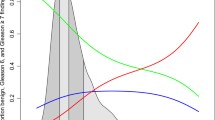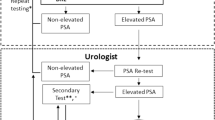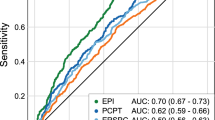Abstract
OBJECTIVE: Calculation of likelihood ratios for serum prostate-specific antigen (PSA) levels to discriminate potentially-curable prostate cancer in men selected for having benign prostatic hyperplasia (BPH) or in randomly selected men.
DESIGN: Retrospective analysis of prospectively measured PSA levels.
SETTING: A tertiary referral center, a multicenter randomized controlled trial, and a community-based study, all providing PSA data.
PATIENTS: We used PSA measurements from four groups of men aged 50 to 79 years: 276 men with organ-confined prostate cancer treated with radical prostatectomy, 305 randomly selected men without clinical evidence of prostate cancer or a history of surgery for BPH recruited for a community study, 173 men without cancer but with BPH coming to prostatectomy, and 770 men without cancer and with symptoms of BPH enrolled in the North American finasteride clinical trial.
MEASUREMENTS AND MAIN RESULTS: Age-standardized, stratum-specific likelihood ratios for organ-confined prostate cancer were calculated separately for unselected men in the community sample and for selected men with BPH (pooling both BPH populations). Likelihood ratios ranged from 0.2 for PSA between 0.0 and 2.0 ng/mL to 54.8 for a PSA level of 10.1 ng/mL or higher in unselected men, but rose to only 2.9 for PSA values of 10.1 ng/mL or higher in men with BPH. Forty percent of the men in the community study had moderate to severe lower urinary tract symptoms. In these men, likelihood ratios ranged from 0.2 for PSA values between 0.0 and 2.0 ng/mL to 17.2 for PSA values of 6.1 ng/mL or higher, while in men with no or mild symptoms, likelihood ratios rose to 26.9 for PSA values of 6.1 ng/mL or higher.
CONCLUSIONS: Likelihood ratios for PSA test results allow stratification of men along a continuum of risk for prostate cancer. Likelihood ratios demonstrate that the ability of the PSA test to discriminate potentially curable prostate cancer from BPH is dramatically lower in men selected with lower urinary tract symptoms than in randomly selected men.
Similar content being viewed by others
References
Potosky AL, Miller BA, Albertson PC, Kramer BS. The role of increasing detection in the rising incidence of prostate cancer. JAMA. 1995;273:548–52.
Jacobsen SJ, Katusic SK, Bergstralh EJ, et al. Incidence of prostate cancer diagnosis in the eras before and after serum prostate-specific antigen testing. JAMA. 1995;274:1445–9.
Meigs JB, Barry MJ, Rimm EB, Giovannucci E, Stampfer MJ, Kawachi I. Are the wrong men receiving PSA testing for early detection of prostate cancer? The Health Professionals Follow-up Study. J Gen Intern Med. 1996;11(suppl):127. Abstract.
Sershon PD, Barry MJ, Oesterling JE. Serum prostate-specific antigen discriminates weakly between men with benign prostatic hyperplasia and patients with organ-confined prostate cancer. Eur Urol. 1994;25:281–7.
Mettlin C, Lee F, Drago J, Murphy GP. The American Cancer Society National Prostate Cancer Detection Project. Findings on the detection of early prostate cancer in 2425 men. Cancer. 1991;67:2949–58.
Catalona WJ, Richie JP, Ahmann FR, et al. Comparison of digital rectal examination and serum prostate specific antigen in the early detection of prostate cancer: results of a multicenter clinical trial of 6,630 men. J Urol. 1994;151:1283–90.
Stamey TA, Yang N, Hay AR, McNeal JE, Freiha FS, Redwine E. Prostate-specific antigen as a serum marker for adenocarcinoma of the prostate. N Engl J Med. 1987;317:909–16.
Oesterling JE. Prostate specific antigen. A critical assessment of the most useful tumor marker for adenocarcinoma of the prostate. J Urol. 1991;145:907–23.
Gillatt D, Reynard JM. What is the normal ‘range’ for prostate-specific antigen? Use of a receiver operating characteristic curve to evaluate a serum marker. Br J Urol. 1995;75:341–6.
Gann PH, Hennekens CH, Stampfer MJ. A prospective evaluation of plasma prostate-specific antigen for detection of prostatic cancer. JAMA. 1995;273:289–94.
Oesterling JE, Jacobsen SJ, Chute CG, et al. Serum prostate-specific antigen in a community-based population of healthy men: establishment of age-specific reference ranges. JAMA. 1993;270:860–4.
Meigs JB, Barry MJ. The natural history of benign prostatic hyperplasia. In: Kirby RS, McConnell JD, Fitzpatrick JM, Roehrborn CG, Boyle P, eds. Textbook of Benign Prostatic Hyperplasia. Oxford, UK: Isis Medical Media, Ltd; 1996;125–35.
Gormley GJ, Stoner E, Bruskewitz RC, et al. The effect of finasteride in men with benign prostatic hyperplasia. N Engl J Med. 1992;327:1185–91.
Guess HA, Heyse JF, Gormley. GJ. The effect of finasteride on prostate-specific antigen in men with benign prostatic hyperplasia. Prostate. 1993;22:31–7.
Sackett DL, Haynes RB, Guyatt GH, Tugwell P. Clinical Epidemiology: A Basic Science for Clinical Medicine. Boston, Mass: Little, Brown and Co; 1991.
Simel DL, Samsa GP, Matchar DB. Likelihood ratios with confidence: sample size estimation for diagnostic test studies. J Clin Epidemiol. 1991;44:763–70.
Barry MJ, Fleming C, Coley CM, Wasson JH, Fahs MC, Oesterling JE. Should Medicare provide reimbursement for prostate-specific antigen testing for early detection of prostate cancer? A four part policy analysis, part I: framing the debate. Urology. 1995;46:2–13.
Simel DL, Samsa GP, Matchar DB. Likelihood ratios for continuous test results—making the clinicians’ job easier or harder? J Clin Epidemiol. 1993;46:85–93.
Chute CG, Panser LA, Girman CJ, et al. The prevalence of prostatism: a population-based survey of urinary symptoms. J Urol. 1993;150:85–9.
Barry M, Fowler F, O’Leary M, et al. The American Urological Association Symptom Index for benign prostatic hyperplasia. J Urol. 1992;148:1549–57.
Catalona WJ, Smith DS, Ratliff TL, et al. Measurement of prostate-specific antigen in serum as a screening test for prostate cancer. N Engl J Med. 1991;324:1156–61.
U.S. Preventive Services Task Force. Guide to Clinical Preventive Services. 2nd ed. Baltimore, Md: William and Wilkins; 1996.
American Urological Association. American Urological Association Executive Committee Report, 1992. Baltimore, Md: American Urological Association; 1992.
Mettlin C, Jones G, Averette H, Gusberg SB, Murphy GP. Defining and updating the American Cancer Society guidelines for the cancer-related checkup: prostate and endometrial cancers. CA. 1993;43:42–7.
Carter HB, Pearson JD, Metter EJ, et al. Longitudinal evaluation of prostate-specific antigen levels in men with and without prostate disease. JAMA. 1992;267:2215–20.
Riehmann M, Rhodes PR, Cook TD, Grose GS, Bruskewitz RC. Analysis of variation in prostate-specific antigen values. Urology. 1993;42:390–7.
Barry MJ; Girman CJ, O’Leary MP, et al. Using repeated measures of symptom score, uroflowmetry and prostate specific antigen in the clinical management of, prostate disease. J Urol. 1995;153:99–103.
Author information
Authors and Affiliations
Additional information
Supported by a Patient Outcomes Research Team (PORT-II) grant from the Agency for Health Care Policy and Research (HS 08397) and by a grant from the U.S. Public Health Service, National Institutes of Health (AR 30582).
Rights and permissions
About this article
Cite this article
Meigs, J.B., Barry, M.J., Oesterling, J.E. et al. Interpreting results of prostate-specific antigen testing for early detection of prostate cancer. J Gen Intern Med 11, 505–512 (1996). https://doi.org/10.1007/BF02599596
Issue Date:
DOI: https://doi.org/10.1007/BF02599596




